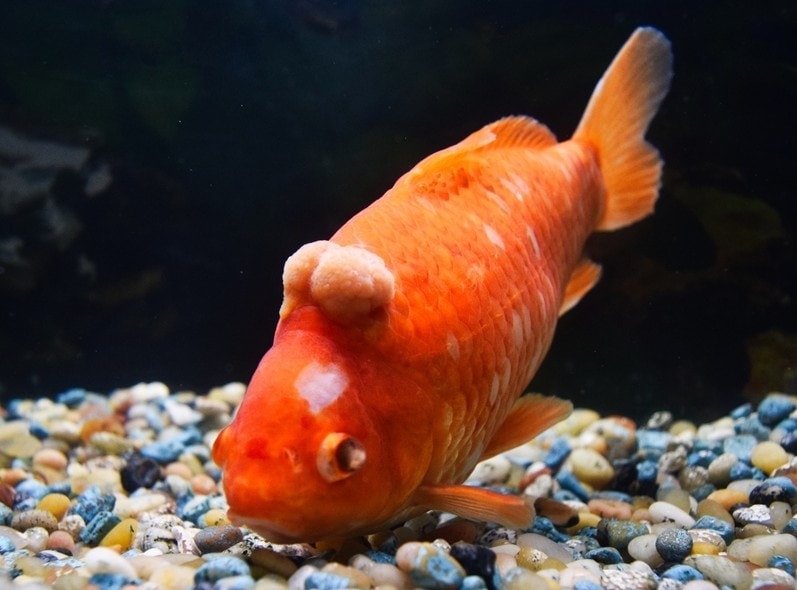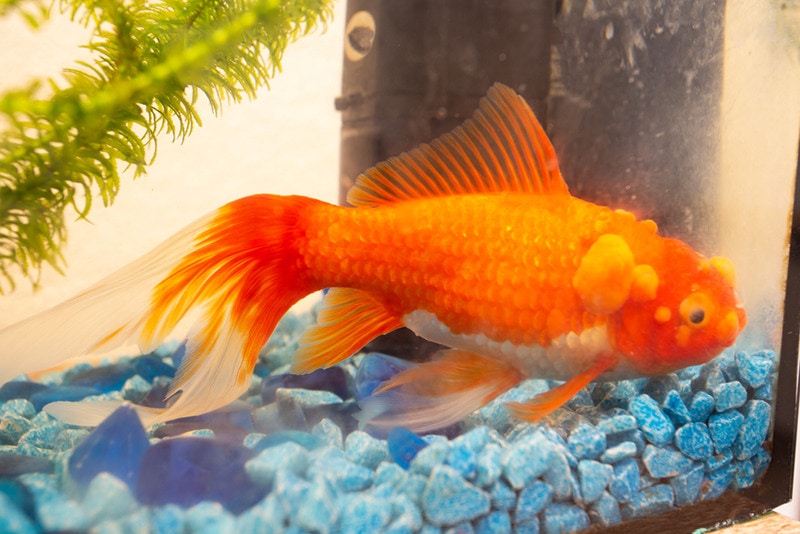Goldfish Tumors: Causes, Signs & Care (Vet Answer)
Updated on

Click to Skip Ahead

What Are Tumors in Goldfish?
Tumors are areas of abnormally increased cell growth, which can be categorized as either benign or malignant. Benign generally means that the tumors spread locally only, while malignant tumors may metastasize to other parts of the body or behave in a more aggressive fashion than benign tumors.
There are MANY different types of tumors within goldfish as a species. Externally visible tumors of goldfish that an owner would find are almost always peripheral nerve sheath tumors, specifically neurofibromas or schwannomas. A study found that in a pond of 400 goldfish, every single external tumor found, including when fish had more than one tumor present, were peripheral nerve sheath tumors.
Due to increased inflammation associated with tumors in fish, compared to land species, differentiating tumor cell types is actually quite difficult and not always possible. When a goldfish develops a peripheral nerve sheath tumor, it’s rare to be able to definitively tell the difference between neurofibromas and schwannomas, but luckily both tumor types are benign, and it isn’t important for treatment to know which type of tumor has grown.
Benign tumors are far more common in goldfish than malignant tumors.
- Chromatophores
- Fibromas
- Fibrosarcomas
- Leiomyomas
- Myxomas
- Perivascular wall tumors
- Perineuriomas
- Malignant schwannomas
What Are the Signs of Tumors in Goldfish?
Tumors in goldfish usually look one of two ways. Option one is a flat, round, raised plaque-like growth, typically pale in color. Option two is a larger, lobulated, protruding round tumor that may grow large enough to get in the way when the fish moves. These tumors typically aren’t covered by scales, and the scales in front of the tumor may be bent outwards a bit.
Though rare, breathing, swimming, or mouth movement may be inhibited by a tumor in goldfish.
If a tumor is internal, a goldfish may develop swim bladder disorder, dropsy, lethargy, loss of appetite, constipation, and organ failure.
External tumors may grow large enough that they actually fall off, leaving an ulcerative-appearing lesion behind, from which the tumor regrows.

What Are the Causes of Tumors in Goldfish?
Tumors may happen for many reasons. Genetics may play a role, as can chronic trauma in an area.
Fish have some unique reasons for developing tumors also, related to living within water, which can expose them to contaminants and pollutants, parasites, toxins, and pathogens. We know that UV radiation and poor water quality are both common causes of tumor growth in addition to what’s listed above. As ectotherms, fish can also be stressed by changes in the temperature of their water, which can make them more susceptible to the growth of tumors.
How Are Goldfish Tumors Diagnosed?
Goldfish tumors are diagnosed the same way tumors in their land counterparts are. Aspirates or biopsies of the growth can be used to identify them. While identifying the exact tumor type is not always possible in fish, these tests can usually differentiate them from other similar growths such as hematomas, hyperpigmentation, granulation tissue, granulomas, lymphocystis (warts) or parasitic lesions.
How Are Tumors in Goldfish Treated?
Most of the time, tumors in goldfish don’t require treatment. Since these are almost always benign, external tumors of the skin, unless they are in a bad location and getting in the way of a goldfish’s normal movements, the tumors can be monitored but left alone. Some tumors will grow big and fall off, then start to regrow again, but this process is associated with little to no bleeding or pain and is, therefore, okay.
When choosing to treat a tumor, surgical removal is usually the treatment of choice. Surgery comes with inherent risks associated with anesthesia, bleeding, shock, infection, and more, so it should only be performed when necessary. Access to aquatic veterinarians that can perform the surgery can be a problem, as can cost.
In some cases, especially small, plaque-like tumors, cryotherapy has been used for treatment, in which extremely cold temperatures kill the tumor cells, but this treatment is only curative, sometimes with higher rates of tumor regrowth than surgery.

How Do I Care for a Goldfish With a Tumor?
Most of the time, you won’t need to change anything for your goldfish that gets a new tumor. Making sure their tank setup allows them to move around freely, monitoring their energy levels, personality, and appetite, and tracking the growth of the tumor are all important steps to take.
Staging photoshoots for your goldfish in which you take high-quality photos of their tumor regularly to track its progress can be very helpful if anything changes in the future and it becomes a concern.
Frequently Asked Questions (FAQ)
Are tumors common in goldfish?
While we don’t have exact statistics, koi and goldfish, which are from the same family, are some of the most likely fish species to develop tumors so in relation to other fish, yes.
Are goldfish warts contagious?
Goldfish warts aren’t actually tumors, even though they look like them. They’re caused by viruses and spread only between fish, so they’re contagious to other goldfish but not to people.
Can you remove a tumor from a goldfish?
You sure can, and these surgeries are some of the coolest ones around. I highly recommend looking up videos of goldfish tumor removals, as the process of anesthesia and surgery in a fish is fascinating.
Conclusion
Goldfish tumors are almost never an issue as they are typically benign and don’t hurt the fish. In the event that they are causing a problem, they can be removed surgically by specially trained veterinarians. Maintaining proper water parameters and diet for your goldfish likely decreases their risk of tumors in the future though we don’t thoroughly understand all the nuances of what causes tumors in fish, especially since this relies on identifying each specific type of tumor, which isn’t always possible in fish.
If you notice a tumor on your goldfish, it likely isn’t a big deal but you can always reach out to a veterinarian to have it checked just in case.
Featured Image Credit: Lindsey Schreiner, Shutterstock













